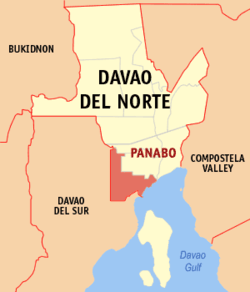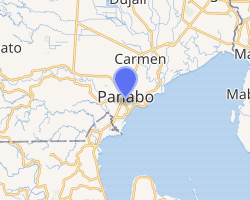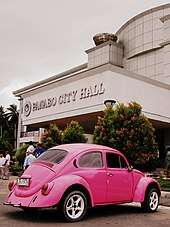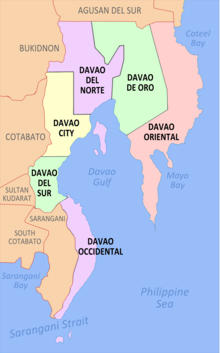Panabo
Panabo, officially the City of Panabo, is a 3rd class city in the province of Davao del Norte, Philippines. According to the 2015 census, it has a population of 184,599 people.[3]
Panabo | |
|---|---|
| City of Panabo | |
 Downtown area | |
 Seal | |
| Nickname(s): Banana Capital of the Philippines | |
 Map of Davao del Norte with Panabo highlighted | |

| |
.svg.png) Panabo Location within the Philippines | |
| Coordinates: 7°18′N 125°41′E | |
| Country | |
| Region | Davao Region (Region XI) |
| Province | Davao del Norte |
| District | 2nd District |
| Founded | July 19, 1949 |
| Cityhood | March 31, 2001 |
| Barangays | 40 (see Barangays) |
| Government | |
| • Type | Sangguniang Panlungsod |
| • Mayor | Jose E. Relampagos |
| • Vice Mayor | Janrey G. Gavina |
| • Congressman | Alan R. Dujali |
| • Electorate | 107,587 voters (2019) |
| Area | |
| • Total | 251.23 km2 (97.00 sq mi) |
| Elevation | 6.5 m (21.3 ft) |
| Population (2015 census)[3] | |
| • Total | 184,599 |
| • Density | 730/km2 (1,900/sq mi) |
| • Households | 41,965 |
| Economy | |
| • Income class | 3rd city income class |
| • Poverty incidence | 19.1% (2015)[4] |
| • Revenue (₱) | 812,896,522.17 (2016) |
| Time zone | UTC+8 (PST) |
| ZIP code | 8105 |
| PSGC | |
| IDD : area code | +63 (0)84 |
| Climate type | tropical rainforest climate |
| Native languages | Ata Manobo Davawenyo Cebuano Kalagan language Tagalog |
| Website | www |
Bordering Davao City to its northeast, Panabo is a part of Davao Metropolitan Area. The city has an area of 25,123 hectares (62,080 acres). The Panabo City Hall is located about 2.23 kilometers from its boundary with Davao City.
Etymology
The name Panabo originated from the phrase "pana-sa-boboy" which means "bow and arrow", the tool which the original inhabitants of the place, the Aetas, use when hunting wild animals for food.[5]
History
Originally the rich lowland of what today is Panabo was inhabited by a group of stocky-haired natives called Aetas. These people led nomadic life and lived by hunting. With the use of their most essential tool, the bow and arrow—"pana-sa-boboy" as they call it—they hunted for food which primarily consisted of rootcrops and meat of wild boars.[5]
Settlers and pioneers from the Visayas and Luzon started to flock the place during the early 1900s in search of a new life in the region. When the first batch of settlers arrived on the place, in what is now the urban core of the city, they found out that it was already a thriving community, and thus called it Taboan, or trading center. Feeling alienated with the massive influx of settlers in the region, the Aeta natives moved further into the hinterlands to the west, thus ensuring that the settler inhabitants become the majority of the population. The new inhabitants started to name the place as Panabo, named after the bow and arrow that the Aeta natives always carry.
Panabo, until then only a mere barangay of Tagum, then known as Magugpo during that time, became a town on 19 July 1949, through Presidential Proclamation No. 236 of the President Manuel A. Roxas.
The Tagum Agricultural Development Company, otherwise known as TADECO, was founded on 20 December 1950 in the town of Panabo.[6] It was the birth of the world's largest Cavendish banana plantation that saw the mass employment of the locals seeking for jobs, and the start of unprecedented growth of the town as even larger throngs of Visayan migrants settled on the town eager to join the plantation's workforce. Large areas of forests were cleared to make way for the banana trees under TADECO. The town of Panabo grew both in economic terms and population as decades passed since the founding of TADECO and numerous businesses were then set up locally, until the conditions finally warranted for its conversion into a city.
The local government unit of Panabo was created into a component city of Davao del Norte by virtue of Republic Act No. 9015 and ratified by the residents in a plebiscite held on March 31, 2001. However, its official existence as a municipal corporation took effect on with the appointment of new set of officials.
Geography
The city of Panabo has a total land area of 251.23 km2. It was bordered by the shores of Davao Gulf to the east, by Davao City to its west and south, and some of the municipalities of Davao del Norte in the north. The western part of the city featured hills while the rest were flatlands.
Barangays
The city is politically subdivided into 40 barangays. Quezon was formerly the sitio of Cabili; it became a barrio in 1957.[7]
- A. O. Floirendo
- Datu Abdul Dadia
- Buenavista
- Cacao
- Cagangohan
- Consolacion
- Dapco
- Gredu (Poblacion)
- J.P. Laurel
- Kasilak
- Katipunan
- Katualan
- Kauswagan
- Kiotoy
- Little Panay
- Lower Panaga (Roxas)
- Mabunao
- Maduao
- Malativas
- Manay
- Nanyo
- New Malaga (Dalisay)
- New Malitbog
- New Pandan (Pob.
- New Visayas
- Quezon
- Salvacion
- San Francisco (Poblacion)
- San Nicolas
- San Pedro
- San Roque
- San Vicente
- Santa Cruz
- Santo Niño (Poblacion)
- Sindaton
- Southern Davao
- Tagpore
- Tibungol
- Upper Licanan
- Waterfall
Climate
| Climate data for Panabo City | |||||||||||||
|---|---|---|---|---|---|---|---|---|---|---|---|---|---|
| Month | Jan | Feb | Mar | Apr | May | Jun | Jul | Aug | Sep | Oct | Nov | Dec | Year |
| Average high °C (°F) | 29 (84) |
30 (86) |
30 (86) |
30 (86) |
31 (88) |
31 (88) |
30 (86) |
30 (86) |
30 (86) |
30 (86) |
30 (86) |
30 (86) |
30 (86) |
| Average low °C (°F) | 22 (72) |
22 (72) |
22 (72) |
22 (72) |
23 (73) |
24 (75) |
24 (75) |
24 (75) |
24 (75) |
24 (75) |
23 (73) |
22 (72) |
23 (73) |
| Average precipitation mm (inches) | 98 (3.9) |
86 (3.4) |
91 (3.6) |
83 (3.3) |
133 (5.2) |
158 (6.2) |
111 (4.4) |
101 (4.0) |
94 (3.7) |
117 (4.6) |
131 (5.2) |
94 (3.7) |
1,297 (51.2) |
| Average rainy days | 16.4 | 14.3 | 16.3 | 18.5 | 25.3 | 25.0 | 23.8 | 21.9 | 20.8 | 24.4 | 24.3 | 18.7 | 249.7 |
| Source: Meteoblue [8] | |||||||||||||
Demographics
| Population census of Panabo | |||||||||||||||||||||||||||||||||||||
|---|---|---|---|---|---|---|---|---|---|---|---|---|---|---|---|---|---|---|---|---|---|---|---|---|---|---|---|---|---|---|---|---|---|---|---|---|---|
|
| ||||||||||||||||||||||||||||||||||||
| Source: Philippine Statistics Authority [3][9][10][11] | |||||||||||||||||||||||||||||||||||||
Economy

Being an agro-industrial city, Panabo is known as the "Banana Capital of the Philippines" due to numerous banana plantations scattered throughout the city. In fact, Panabo is the home of the world's biggest banana plantation, which is owned by the Tagum Agricultural Development Company (TADECO), which covers around 6,900 hectares of banana fields and produce millions of boxes of export-quality bananas annually. The city itself cultivated 40% of its land or around 10,000 hectares into planting export-quality Cavendish bananas. Thus, banana cultivation and exportation are the main economic lifeblood of the city.
Infrastructure

There are two privately owned port facilities in the city, which enabled them to export various fruits, such as bananas, mangoes, papayas, and pineapples, to countries like Japan, Korea, China, and countries as far in the Middle East and the European Union.
Public infrastructure includes the Freedom Park which features a unique banana inspired fountain sculpted by the world class artist Kublai Millan. The Panabo Multi-Purpose Cooperative Tourism Gymnasium, located beside the City Hall is also a public infrastructure, the gymnasium accommodates an estimated ten-thousand people and also serves as playing venue of the Philippine Basketball Association as well as serving concerts for the city.
Transportation
Panabo is served by the 6-lane Maharlika Highway and is a highway road junction heading to the TADECO banana plantation as well as to other parts of Davao del Norte and the northernmost areas of Davao City. Tricycles and jeepneys are the main mode of transportation in the city, while passenger buses and public utility vans serve overland routes within and outside the city.
Education
- Universities
- North Davao Colleges (private)
- University of Mindanao, Panabo College (private)
- Davao del Norte State College (public)
- Colleges
- ACES Polytechnic College of Panabo
- NorthLink Technological College, Inc.
- Valiant Technological College
- Northern Paramedical and Technological College
- The Leores Training Academy Inc.
- High-schools
- Davao del Norte State College Laboratory School (private)
- North Davao Colleges - High School Department (private)
- Maryknoll College of Panabo (private)
- Francisco Adlaon Learning Institute (private)
- Panabo SDA Learning Center (private)
- Panabo Christian School (private)
- Panabo Achievers Academy (2nd year only) (private)
- Panabo National High School (public)
- Little Panay National High School (Panabo National High School Annex)
- Colegio de Davao, Panabo City (Private)
- Good Shepherd Baptist School (Church School)
- A. O. Floirendo National High School
- Don M. Javellana National High School
- Kauswagan National High School
- Mabunao High School
- Malativas National High School
- Manay National High School
- San Vicente National High School (Panabo National High School Annex)
- Sindaton National High School
- Southern Davao National High School[12]
A memorandum of agreement between UP Los Baños College of Agriculture and ANFLOCOR was signed for the establishment of UP Professional School for Agriculture and the Environment (UP PSAE) which will be UPLB's extension campus in Panabo City.[13][14][15] In addition, UP Mindanao will also collaborate on some courses and programs to be offered.[16]
Notable people
- Jerwin Ancajas, boxer
- Dennis Denora, journalist and publisher
- Thor Dulay, The Voice Ph semifinalist
- Jasmine Bacurnay Lee, Korean actress and politician
References
- "City". Quezon City, Philippines: Department of the Interior and Local Government. Retrieved 30 May 2013.
- "Province: Davao del Norte". PSGC Interactive. Quezon City, Philippines: Philippine Statistics Authority. Retrieved 12 November 2016.
- Census of Population (2015). "Region XI (Davao Region)". Total Population by Province, City, Municipality and Barangay. PSA. Retrieved 20 June 2016.
- "PSA releases the 2015 Municipal and City Level Poverty Estimates". Quezon City, Philippines. Retrieved 12 October 2019.
- "City Profile". Local Government of Panabo City. Archived from the original on 31 December 2012. Retrieved 30 April 2014.
- "Incorporated (TADECO, Inc.), Tagum Agricultural Development Company". www.globalgap.org.
- "An Act Converting the Sitio of Cabili, Municipality of Panabo, Province of Davao, into a Barrio of Said Municipality to Be Known As the Barrio of Quezon". LawPH.com. Retrieved 2011-04-12.
- "Panabo: Average Temperatures and Rainfall". Meteoblue. Retrieved 29 February 2020.
- Census of Population and Housing (2010). "Region XI (Davao Region)". Total Population by Province, City, Municipality and Barangay. NSO. Retrieved 29 June 2016.
- Censuses of Population (1903–2007). "Region XI (Davao Region)". Table 1. Population Enumerated in Various Censuses by Province/Highly Urbanized City: 1903 to 2007. NSO.
- "Province of Davao del Norte". Municipality Population Data. Local Water Utilities Administration Research Division. Retrieved 17 December 2016.
- "Philippines Schools: Panabo City Public High School". July 17, 2012.
- "Archived copy". Archived from the original on 2017-03-21. Retrieved 2017-03-21.CS1 maint: archived copy as title (link)
- "Archived copy". Archived from the original on 2017-03-21. Retrieved 2017-03-21.CS1 maint: archived copy as title (link)
- "UPLB to put up satellite campus in Panabo City". June 29, 2016.
- "Archived copy". Archived from the original on 2017-03-21. Retrieved 2017-03-21.CS1 maint: archived copy as title (link)
External links
| Wikivoyage has a travel guide for Panabo. |
| Wikimedia Commons has media related to Panabo City. |
- Panabo City official website
- Panabo Profile at PhilAtlas.com
- Philippine Standard Geographic Code
- Philippine Census Information
- Local Governance Performance Management System
- Davao Travel and Tourism Guide
- https://web.archive.org/web/20130429030058/http://tagumcoop.org/index.php/contactus/panabo-branch
